Crab
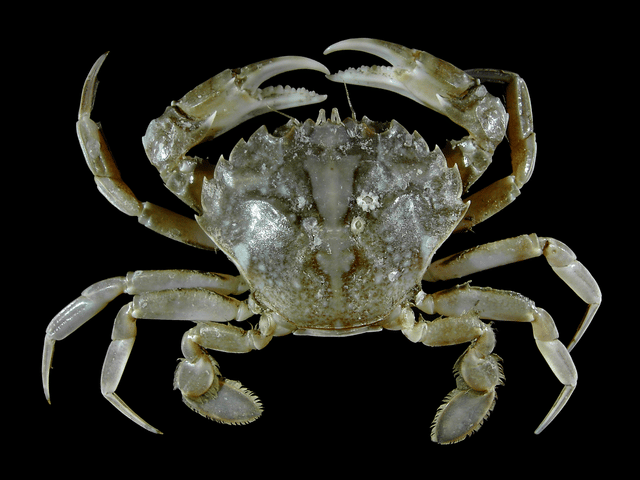
Crab

| Crab | |
|---|---|
| Grey swimming crabLiocarcinus vernalis | |
| Scientific classification | |
| Kingdom: | Animalia |
| Phylum: | Arthropoda |
| Subphylum: | Crustacea |
| Class: | Malacostraca |
| Order: | Decapoda |
| Suborder: | Pleocyemata |
| Infraorder: | Brachyura ,1758 |
| Sections and subsections[1] | |
Crabs are decapod crustaceans of the infraorder Brachyura, which typically have a very short projecting "tail" (abdomen) (Greek: βραχύς, romanized: brachys = short,[2] οὐρά / οura = tail[3]), usually entirely hidden under the thorax. They live in all the world's oceans, in fresh water, and on land, are generally covered with a thick exoskeleton and have a single pair of pincers. Many other animals with similar names – such as hermit crabs, king crabs, porcelain crabs, horseshoe crabs, and crab lice – are not true crabs.
| Crab | |
|---|---|
| Grey swimming crabLiocarcinus vernalis | |
| Scientific classification | |
| Kingdom: | Animalia |
| Phylum: | Arthropoda |
| Subphylum: | Crustacea |
| Class: | Malacostraca |
| Order: | Decapoda |
| Suborder: | Pleocyemata |
| Infraorder: | Brachyura ,1758 |
| Sections and subsections[1] | |
Description
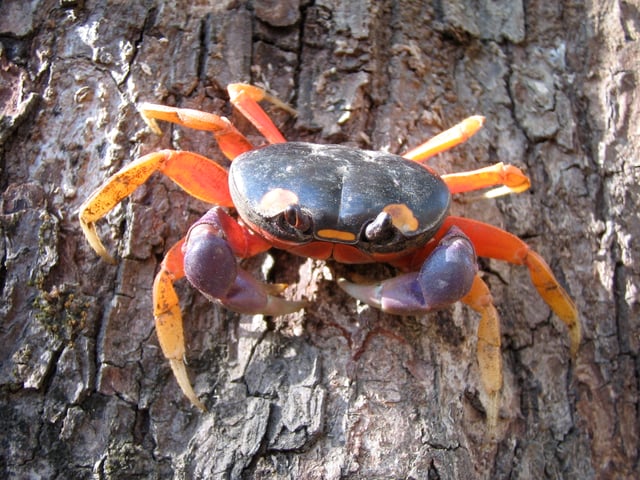
Gecarcinus quadratus, a land crab from Central America
Crabs are generally covered with a thick exoskeleton, composed primarily of highly mineralized chitin,[4][5] and armed with a single pair of chelae (claws). Crabs are found in all of the world's oceans, while many crabs live in fresh water and on land, particularly in tropical regions. Crabs vary in size from the pea crab, a few millimetres wide, to the Japanese spider crab, with a leg span of up to 4 metres (13 ft).[6]
Environment
Evolution
The earliest unambiguous crab fossils date from the Jurassic,[9] although Carboniferous Imocaris, known only from its carapace, may be a primitive crab.[10] The radiation of crabs in the Cretaceous and afterward may be linked either to the break-up of Gondwana or to the concurrent radiation of bony fish, crabs' main predators.[11]
Sexual dimorphism
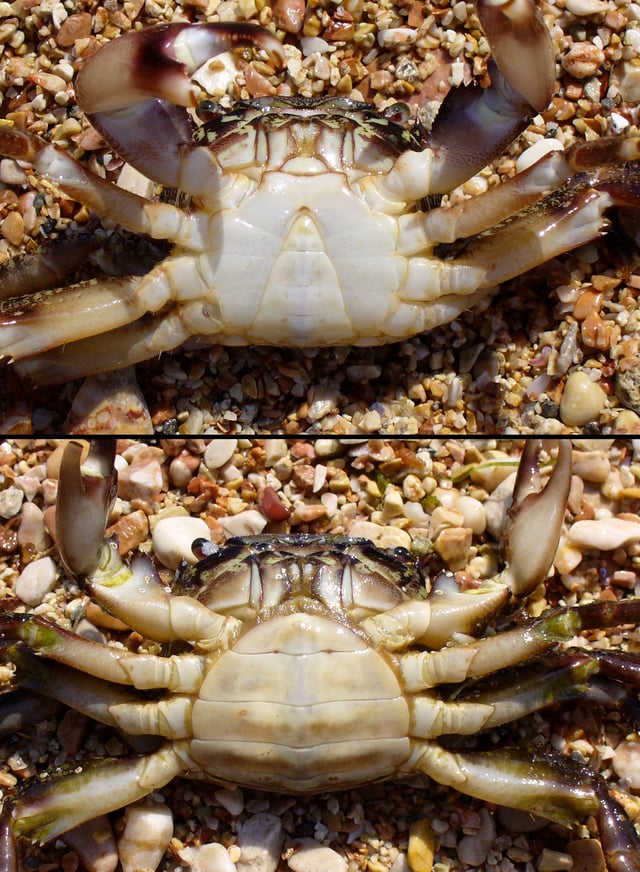
The underside of a male (top) and a female (bottom) individual of Pachygrapsus marmoratus
Crabs often show marked sexual dimorphism. Males often have larger claws,[12] a tendency which is particularly pronounced in the fiddler crabs of the genus Uca (Ocypodidae). In fiddler crabs, males have one claw which is greatly enlarged and which is used for communication, particularly for attracting a mate.[13] Another conspicuous difference is the form of the pleon (abdomen); in most male crabs, this is narrow and triangular in form, while females have a broader, rounded abdomen.[14] This is because female crabs brood fertilised eggs on their pleopods.
Reproduction and lifecycle
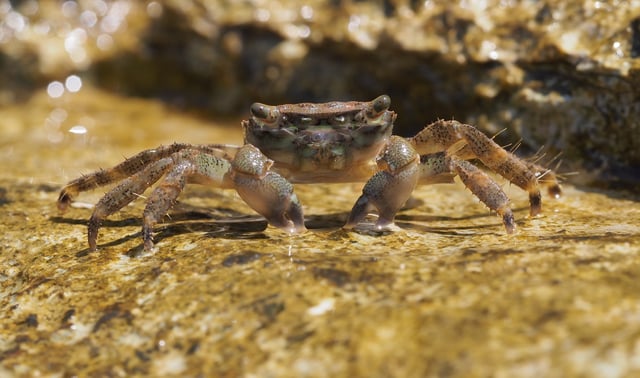
Crab (Pachygrapsus marmoratus) on Istrian coast, Adriatic Sea
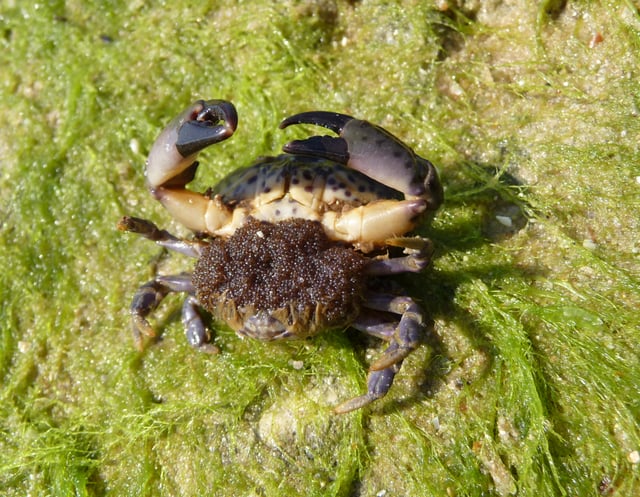
Female crab Xantho poressa at spawning time in the Black Sea, carrying eggs under her abdomen

A Grapsus tenuicrustatus climbing up a rock in Hawaii
Crabs attract a mate through chemical (pheromones), visual, acoustic, or vibratory means. Pheromones are used by most fully aquatic crabs, while terrestrial and semiterrestrial crabs often use visual signals, such as fiddler crab males waving their large claws to attract females. The vast number of brachyuran crabs have internal fertilisation and mate belly-to-belly. For many aquatic species, mating takes place just after the female has moulted and is still soft. Females can store the sperm for a long time before using it to fertilise their eggs. When fertilisation has taken place, the eggs are released onto the female's abdomen, below the tail flap, secured with a sticky material. In this location, they are protected during embryonic development. Females carrying eggs are called "berried" since the eggs resemble round berries.
When development is complete, the female releases the newly hatched larvae into the water, where they are part of the plankton. The release is often timed with the tides. The free-swimming tiny zoea larvae can float and take advantage of water currents. They have a spine, which probably reduces the rate of predation by larger animals. The zoea of most species must find food, but some crabs provide enough yolk in the eggs that the larval stages can continue to live off the yolk.
Each species has a particular number of zoeal stages, separated by moults, before they change into a megalopa stage, which resembles an adult crab, except for having the abdomen (tail) sticking out behind. After one more moult, the crab is a juvenile, living on the bottom rather than floating in the water. This last moult, from megalopa to juvenile, is critical, and it must take place in a habitat that is suitable for the juvenile to survive.[15]
Most species of terrestrial crabs must migrate down to the ocean to release their larvae; in some cases, this entails very extensive migrations. After living for a short time as larvae in the ocean, the juveniles must do this migration in reverse. In many tropical areas with land crabs, these migrations often result in considerable roadkill of migrating crabs.[15]
Once crabs have become juveniles, they will still have to keep moulting many more times to become adults.
They are covered with a hard shell, which would otherwise prevent growth.
The moult cycle is coordinated by hormones. When preparing for moult, the old shell is softened and partly eroded away, while the rudimentary beginnings of a new shell form under it. At the time of moulting, the crab takes in a lot of water to expand and crack open the old shell at a line of weakness along the back edge of the carapace. The crab must then extract all of itself – including its legs, mouthparts, eyestalks, and even the lining of the front and back of the digestive tract – from the old shell. This is a difficult process that takes many hours, and if a crab gets stuck, it will die. After freeing itself from the old shell (now called an exuvia), the crab is extremely soft and hides until its new shell has hardened. While the new shell is still soft, the crab can expand it to make room for future growth.[15]
Behaviour
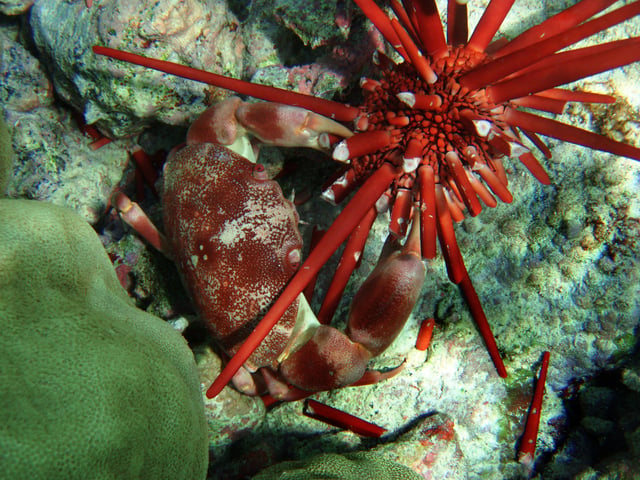
Carpilius convexus consuming Heterocentrotus trigonarius
Crabs typically walk sideways[16] (a behaviour which gives us the word crabwise), because of the articulation of the legs which makes a sidelong gait more efficient.[17] However, some crabs walk forwards or backwards, including raninids,[18] Libinia emarginata[19] and Mictyris platycheles.[16] Some crabs, notably the Portunidae and Matutidae, are also capable of swimming,[20] the Portunidae especially so as their last pair of walking legs is flattened into swimming paddles.[15]
Crabs are mostly active animals with complex behaviour patterns.
They can communicate by drumming or waving their pincers. Crabs tend to be aggressive towards one another, and males often fight to gain access to females.[21] On rocky seashores, where nearly all caves and crevices are occupied, crabs may also fight over hiding holes.[22] Fiddler crabs]](genus d, which they use for resting, hiding, and mating, and to defend against intruders.[15]
Crabs are omnivores, feeding primarily on algae,[23] and taking any other food, including molluscs, worms, other crustaceans, fungi, bacteria and detritus, depending on their availability and the crab species. For many crabs, a mixed diet of plant and animal matter results in the fastest growth and greatest fitness.[24][25] However, some species are more specialised in their diets. Some eat plankton, some eat primarily shellfish like clams, and some even catch fish.[15]
Crabs are known to work together to provide food and protection for their family, and during mating season to find a comfortable spot for the female to release her eggs.[26]
Human consumption
Fisheries

Fishermen sorting velvet crabs at Fionnphort, Scotland
Crabs make up 20% of all marine crustaceans caught, farmed, and consumed worldwide, amounting to 1.5 million tonnes annually. One species, Portunus trituberculatus, accounts for one-fifth of that total. Other commercially important taxa include Portunus pelagicus, several species in the genus Chionoecetes, the blue crab (Callinectes sapidus), Charybdis spp.spp.]] Cancer pagurus Dungeness crab (Metacarcinus magister), and Scylla serrata, each of which yields more than 20,000 tonnes annually.[27]
Cookery
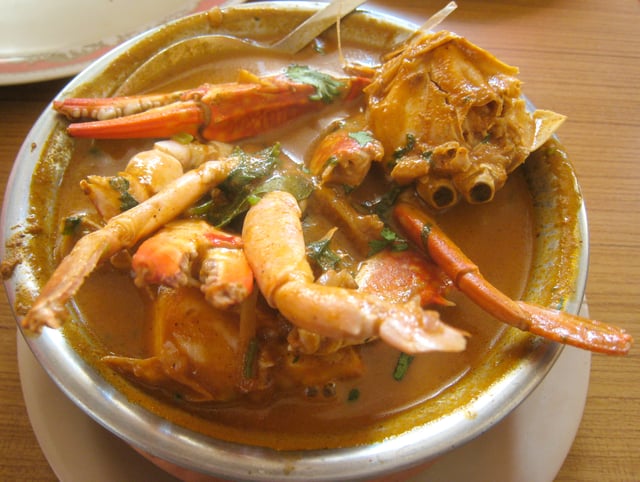
Crab masala from Karnataka, India
Crabs are prepared and eaten as a dish in many different ways all over the world.
Some species are eaten whole, including the shell, such as soft-shell crab; with other species, just the claws or legs are eaten. The latter is particularly common for larger crabs, such as the snow crab. In many cultures the roe of the female crab is also eaten, which usually appears orange or yellow in fertile crabs. This is popular in southeast Asian cultures, some Mediterranean and northern European cultures, as well as on the eastern, Chesapeake and southern coasts of the United States.
In some regions, spices improve the culinary experience.
In Southeast Asia and the Indosphere, masala crab and chilli crab are examples of heavily spiced dishes. In the Chesapeake Bay region, blue crab is often steamed with Old Bay Seasoning. Alaskan king crab or snow crab legs are usually simply boiled and served with garlic or lemon butter.
For the British dish dressed crab, the crab meat is extracted and placed inside the hard shell. One American way to prepare crab meat is by extracting it and adding varying amounts of binders, such as egg white, cracker meal, mayonnaise or mustard, creating a crab cake. Crabs can also be made into a bisque, a global dish of French origin which in its authentic form includes in the broth the pulverized shells of the shellfish from which it is made.
Imitation crab, also called surimi, is made from minced fish meat that is crafted and colored to resemble crab meat. While it is sometimes disdained among some elements of the culinary industry as an unacceptably low-quality substitute for real crab, this does not hinder its popularity, especially as a sushi ingredient in Japan and South Korea, and in home cooking, where cost is often a chief concern.[31] Indeed, surimi is an important source of protein in most East and Southeast Asian cultures, appearing in staple ingredients such as fish balls and fish cake.
Pain
Crabs are often boiled alive.
In 2005, Norwegian scientists concluded that crustaceans could not feel pain.[32] However, a study by Bob Elwood and Mirjam Appel of Queens University in Belfast, found that hermit crabs reacted to electric shocks. This may indicate that some crustaceans are able to feel and remember pain.[33][34]
Classification
The infraorder Brachyura contains 6,793 species in 93 families,[20] as many as the remainder of the Decapoda.[35] The evolution of crabs is characterised by an increasingly robust body, and a reduction in the abdomen. Although many other groups have undergone similar processes, carcinisation is most advanced in crabs. The telson is no longer functional in crabs, and the uropods are absent, having probably evolved into small devices for holding the reduced abdomen tight against the sternum.
In most decapods, the gonopores (sexual openings) are found on the legs. However, since crabs use the first two pairs of pleopods (abdominal appendages) for sperm transfer, this arrangement has changed. As the male abdomen evolved into a narrower shape, the gonopores have moved towards the midline, away from the legs, and onto the sternum.[36] A similar change occurred, independently, with the female gonopores. The movement of the female gonopore to the sternum defines the clade Eubrachyura, and the later change in the position of the male gonopore defines the Thoracotremata. It is still a subject of debate whether those crabs were the female, but not male, gonopores are situated on the sternum, form a monophyletic group.[35]
Superfamilies
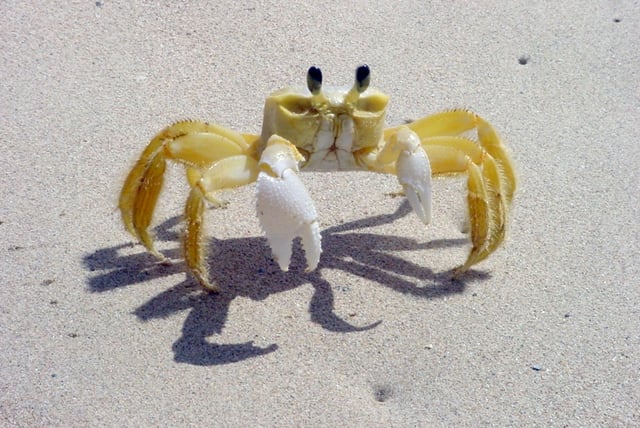
Ocypode quadrata (Thoracotremata: Ocypodidae)
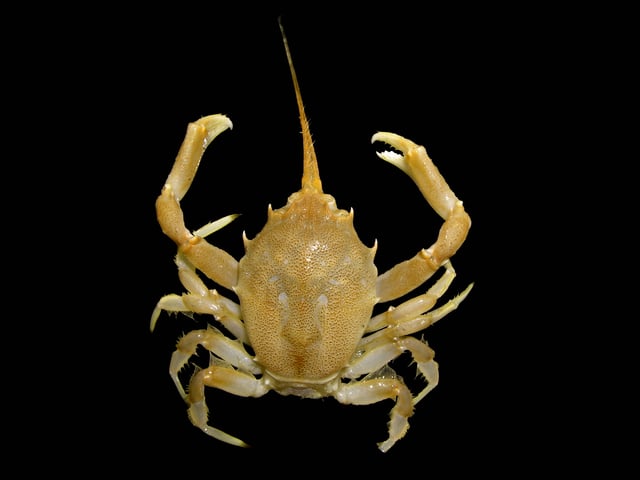
Corystes cassivelaunus (Heterotremata: Corystidae)
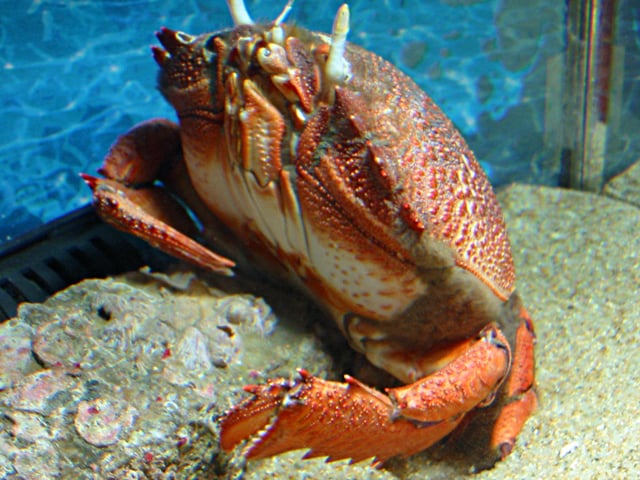
Ranina ranina (Raninoida: Raninidae)
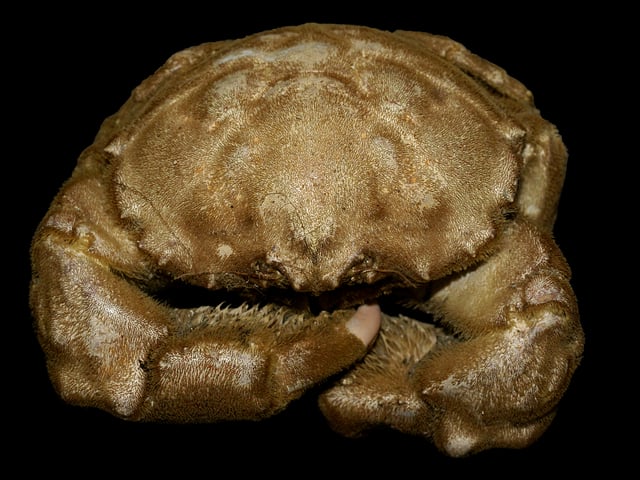
Dromia personata (Dromiacea: Dromiidae)
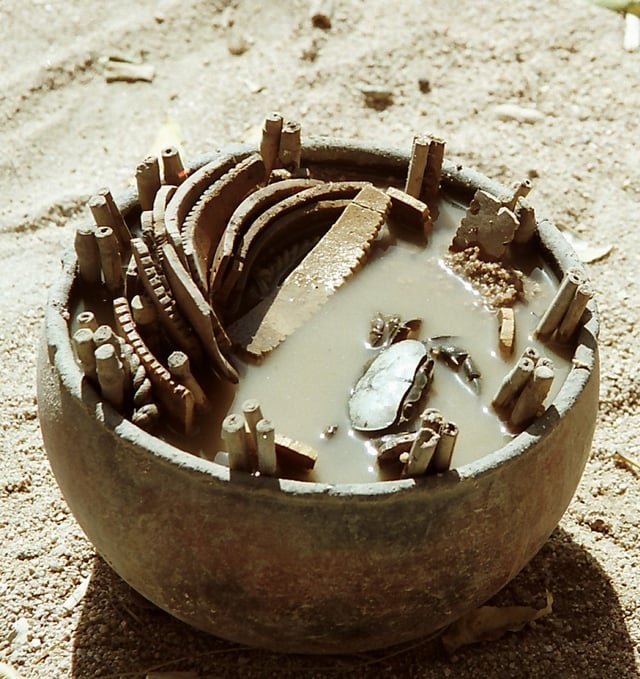
A crab divination pot in Kapsiki, North Cameroon.
Callichimaeroida †Callichimaeroidea (1†)[38]
Dromiacea †Dakoticancroidea (6†) Dromioidea (147, 85†) Glaessneropsoidea (45†) Homolodromioidea (24, 107†) Homoloidea (73, 49†)
Raninoida
Cyclodorippoida
Eubrachyura Heterotremata Aethroidea (37, 44†) Bellioidea (7) Bythograeoidea (14) Calappoidea (101, 71†) Cancroidea (57, 81†) Carpilioidea (4, 104†) Cheiragonoidea (3, 13†) Corystoidea (10, 5†) †Componocancroidea (1†) Dairoidea (4, 8†) Dorippoidea (101, 73†) Eriphioidea (67, 14†) Gecarcinucoidea (349) Goneplacoidea (182, 94†) Hexapodoidea (21, 25†) Leucosioidea (488, 113†) Majoidea (980, 89†) Orithyioidea (1) Palicoidea (63, 6†) Parthenopoidea (144, 36†) Pilumnoidea (405, 47†) Portunoidea (455, 200†) Potamoidea (662, 8†) Pseudothelphusoidea (276) Pseudozioidea (22, 6†) Retroplumoidea (10, 27†) Trapezioidea (58, 10†) Trichodactyloidea (50) Xanthoidea (736, 134†) Thoracotremata Cryptochiroidea (46) Grapsoidea (493, 28†) Ocypodoidea (304, 14†) Pinnotheroidea (304, 13†)
Cultural influences
Both the constellation Cancer and the astrological sign Cancer are named after the crab, and depicted as a crab. William Parsons, 3rd Earl of Rosse drew the Crab Nebula in 1848 and noticed its similarity to the animal; the Crab Pulsar lies at the centre of the nebula.[39] The Moche people of ancient Peru worshipped nature, especially the sea,[40]*The%20Mochica%3A%20A%20Culture%20o]]*nd often depicted crabs in their art.Greek mythology Karkinos Lernaean Hydra Heracles Rudyard Kipling The Crab that Played with the Seahe sea go up and down, like the tides.[42]
The Kapsiki people of North Cameroon use the way crabs handle objects for divination.